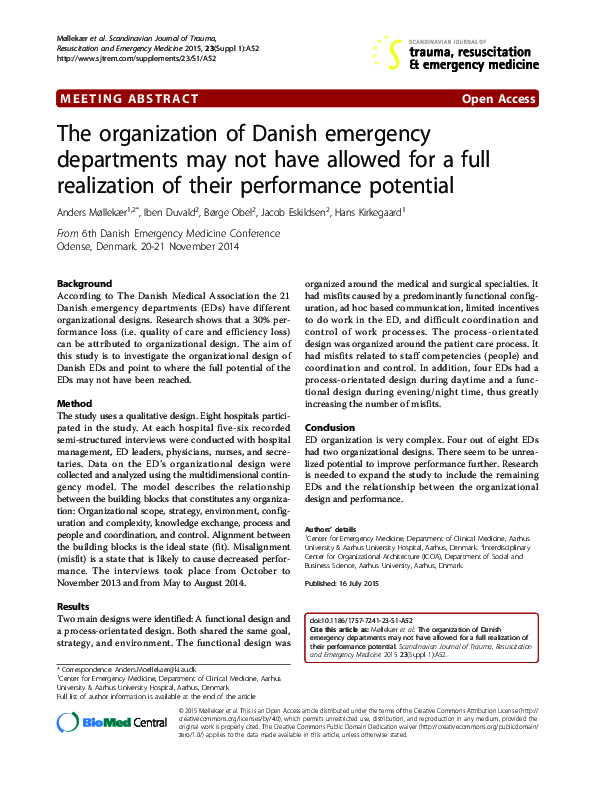Academia.edu no longer supports Internet Explorer.
To browse Academia.edu and the wider internet faster and more securely, please take a few seconds to upgrade your browser.
The organization of Danish emergency departments may not have allowed for a full realization of their performance potential
The organization of Danish emergency departments may not have allowed for a full realization of their performance potential
2015, Scandinavian Journal of Trauma, Resuscitation and Emergency Medicine
Related Papers
Scandinavian Journal of Trauma, Resuscitation and Emergency Medicine
Hoping for a domino effect: a new specialty in Sweden is a breath of fresh air for the development of Scandinavian emergency medicine2013 •
African Journal of Emergency Medicine
Emergency clinician output in a district hospital emergency centre: a cross-sectional analysisAnnals of Emergency Medicine
A framework for classifying factors that contribute to error in the emergency department2003 •
2013 •
Introduction: Emergency department performance index (EPI) greatly influences the function of other hospital’s units and also patient satisfaction. Recently, the Iranian Ministry of Health has defined specific national EPI containing five indexes. In the present study, the performance indexes of emergency department (ED) in one educational hospital has been assessed before and after establishment of emergency medicine. Methods: In the present cross-sectional study the ED of Shohadaye Tajrish Hospital, Tehran, Iran has been assessed during one-year period from March 2012 to February 2013. The study was divided into two six-month periods, before and after establishment of emergency medicine. Five performance indexes including: the percentage of patients were disposed during 6-hour, leaved the ED in a 12-hour, had unsuccessful cardiopulmonary resuscitation (CPR), discharged against medical advice, and the mean time of triage were calculated using data of department of medical records on daily patients’ files. Then, Mann-Whitney U test was used to make comparisons at P<0.05. Results: The aver-age triage time decreased from 6.04 minutes in the first six months to 1.5 minutes in the second six months (P=0.06). The percentage of patients leaving the ED in a 12-hour decreased from 97.3% to 90.4% (P=0.004). However, the percentage of disposed patients during 6-hour (P=0.2), unsuccessful CPR (P=0.34) and discharged against medical advice (P=0.42) did not differ between the two periods. Conclusion: It seems that establishment of emergency medicine could be able to improve ED performance indexes such as time to triage and leave in a 12-hour period.
The International journal of health planning and management
Emergency departments key performance indicators: A unified framework and its practice2018 •
Resuscitation
Scandinavian pre-hospital physician-manned Emergency Medical Services—Same concept across borders?2010 •
Emergency Medicine Journal
A Delphi study to identify performance indicators for emergency medicine2004 •
Emergency Medicine Australasia
Emergency Department Workforce Models: What the literature can tell us2011 •
RELATED PAPERS
Archaeologies. Journal of the World Archaeological Congress
Postcolonialism as a Reverse Discourse in Egyptology: De-colonizing Historiography and Archaeology of Ancient Egypt and Nubia Part 22023 •
What Film Is Good For: On the Values of Spectatorship
An Animated and Animating Medium: On Hegel, Adorno, and the Good of Film2023 •
Northern Illinois University Law Review
THE RULE OF LAW: "A" RELATION BETWEEN LAW AND MORALS2022 •
Iowa Science Teachers Journal
We All Teach the Nature of Science - Whether Accurately or Not2008 •
Advance Journal of Food Science and Technology
Optimization of Chaetoceros gracilis Microalgae Production for Fish Feeding Using an Airlift Photobioreactor2018 •
Connectivity matters!
Connectivity and fortifications2023 •
Asymptotic Analysis
Characterizations of anisotropic high order Sobolev spaces2019 •
African Journal of Urology
Prostate cancer (PC)-management of 669 cases in Ghana West Africa2014 •
Annals of Dentistry
Impact strength of an experimental polyurethane- based polymer2007 •
Hanover and England – a garden and personal union?
Between traditions: The Hanoverians’ taste in gardens2018 •
2020 •
2009 International Symposium on Collaborative Technologies and Systems
A new framework for on-demand virtualization, repurposing and fusion of heterogeneous sensors2009 •
Revista Brasileira Multidisciplinar
Educação em saúde com gestantes e mães sobre noções de cuidado com o neonato2018 •

 Jacob Eskildsen
Jacob Eskildsen